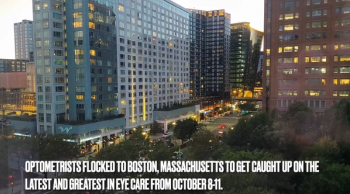
- June digital edition 2020
- Volume 12
- Issue 6
Resolved cotton-wool spot leaves RNFL defect in its wake
Imaging reveals diabetic retinopathy, cotton wool spot, and resulting RNFL defect.
A 55-year old patient with a 20-year history of insulin-dependent diabetes presented for periodic ophthalmic evaluation. He was new to our area and did not recall the timing of his previous examination.
Symptoms
He reported no visual symptoms. In addition to his history of diabetes, he had also been treated for systemic hypertension (medications unreported) for 20 years. Significant in his history was the admission of blood sugar levels in the 140 to 200 range. He was unaware of his HbA1c levels.
At examination, best-corrected visual acuity was 20/25 in each eye. The appearance of the right and left fundi is depicted in Figure 1. Note the vascular abnormalities in each eye consistent with diabetic retinopathy, including hemorrhages and microaneurysms, cotton-wool spots, intraretinal microvascular abnormalities, and a specific cluster of exudates affecting the left eye within 500 μm of the macula. In the fundus photo of the right eye, note particularly the vascular irregularity associated with cotton-wool spot superior temporal to the optic disc.
Diagnosis
The patient was diagnosed with moderate to severe diabetic retinopathy, and optical coherence tomography (OCT) was ordered. Normal foveal contour with mild thickening as well as absence of intra- and sub-retinal fluid are noted in the cross-sectional presentation of each eye. See Figure 2.
Topographical analysis revealed mild thickening within the posterior pole of each eye. See Figure 3. The retinal nerve fiber layer (RNFL) profile captured a portion of the cotton-wool spot superior temporal to the optic disc of the right eye. See Figure 4.
The patient refused consultation with a retinologist and was subsequently advised to follow up in 3 months. At this visit, his visual acuity was unchanged, but there were some changes to the fundus appearance in each eye. See Figure 5 for changes to the right eye.
Most significantly, the prominent cotton-wool spot in the right eye had resolved but left in its wake a distinct RNFL defect. Refer to Figure 5.
The OCT at this visit revealed intra-retinal and sub-retinal fluid perilously close to the center of the fovea of the right eye. See Figure 6.
This was considered potentially treatable although not center-involving, and the patient was referred to a retinologist. Treatment was recommended, and the patient refused.
Assessment
It is well known that cotton-wool spots are consistent with underlying ischemia, perhaps of a single retinal arteriole.1 They have been reported to correspond with arcuate visual-field defects.2
The specific pathophysiology for the manifestation of CWS appears to begin with retinal arteriolar obstruction. As such, CWS can be regarded as sentinels for neovascularization.
A previous report of CWS resolution with subsequent RNFL defect was published.3 The case involved a patient with severe arterial hypertension whose CWS appeared inferior to the optic disc. Upon CWS resolution, the patient exhibited a distinct wedge-shaped RNFL defect. The report also included OCT analysis showing characteristic inner retinal tissue loss.
On further follow-up, the current patient eventually developed center-involving macular edema in the right eye and high-risk vitreous hemorrhage (nasal to the optic disc) in the left eye.
He received a single treatment to the left eye but was lost to subsequent follow-up.
References:
1. McLeod D. Why cotton wool spots should not be regarded as retinal nerve fibre layer infarcts. Br J Ophthalmol. 2005 Feb;89(2):229-37.
2. Chui TY, Thibos LN, Bradley A, Burns SA. The mechanisms of vision loss associated with a cotton wool spot. Vision Res. 2009 Nov;49(23):2826-34.
3. Zhang L, Xu L, Zhang JS, Zhang YQ, Yang H, Jonas J. Cotton-wool spot and optical coherence tomography of a retinal nerve fiber layer defect. Arch Ophthalmol. 2012 Jul 1;130(7):913.
Articles in this issue
over 5 years ago
Moncler Lunettes sunglass and eyeglass collection 2020over 5 years ago
Telehealth success hinges on better toolsover 5 years ago
Lactoferrin levels can diagnose dry eye diseaseover 5 years ago
Patients aren’t hearing contact lens care informationover 5 years ago
11 things my patient wished her previous OD had told herover 5 years ago
Proper documentation helps assure prior authorizationsover 5 years ago
What a practice owner would advise her younger selfover 5 years ago
OCT, OCTA show promise in screening for DRNewsletter
Want more insights like this? Subscribe to Optometry Times and get clinical pearls and practice tips delivered straight to your inbox.









































